Table of Contents
As much as you might love marketing your brand with billboards or radio ads, social media for business has to be part of your marketing strategy in 2024. Sorry!
Social media is an essential way to reach your customers, gain valuable insights, and grow your brand.
If you’re avoiding this powerful communication tool, you’re missing out on an incredible opportunity to connect with an audience. (Is this the “inner saboteur” RuPaul is always talking about?!)
Read on for everything you need to know to build a winning social media marketing strategy for your business.
Bonus: Get a free social media strategy template to quickly and easily plan your own strategy. Also use it to track results and present the plan to your boss, teammates, and clients.
We get it; you’re a busy businessperson who just wants to cut to the chase so you can go out and achieve fame and fortune.
Here’s a quick (and hopefully convincing?) list of how to use social media for business.
Increase brand awareness
Using social media for business offers an opportunity to create and share content to raise awareness about your brand. Consistently post relevant and engaging content, and word may just trickle out across the internet about all the cool things you’re doing.
Parody magazine Hot Teen used Instagram to build an audience before launching its first issue, because step one of any business plan should be “making sure people know you exist.”

Source: @hotteenmagazine on Instagram
Engage directly with your customers
Another benefit of social media for businesses? Social media platforms can provide a direct line of communication between companies and their customers.
On Facebook, Instagram, and X, companies can interact with their audience directly or publicly in a way that feels more responsive and personal than email or a 1-800 hotline.
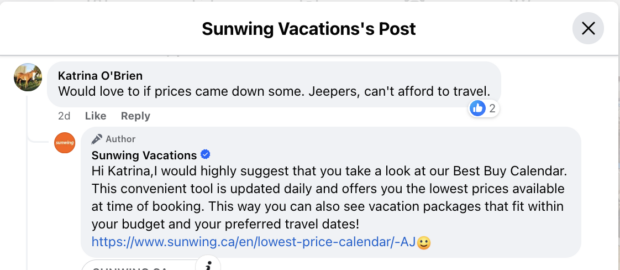 Source: Sunwing Vacations on Facebook
Source: Sunwing Vacations on Facebook
Use this intimate communication method to respond to inquiries, address concerns, and build a stronger relationship with their customers. (Brush up on social media customer service tips here!)
Promote your content
Think of social media as your own personal publishing outlet. Use your Facebook account to drive traffic to blog posts, share an article on your X account, and distribute a video via TikTok.
You’ve put lots of hard work into crafting informative or entertaining content for your potential customers and existing audience — use the magic of social media to actually get it in front of people.
Just look at comedy club Comedy Here Often, which uses social accounts to share clips from its live shows.
Generate new sales leads
Potential customers are hangin’ on social every single day… go get ‘em, tiger!
Not only do you have an avenue to build relationships and practice social selling here, but social media platforms also offer advertising and targeting options.
Target specific audiences based on demographics, interests, and behaviors, and build a deep roster of sales leads.
Conduct market research
Get comfortable using social media analytics tools and practicing social listening, and you’ll find yourself awash in incredible market intel.
Social media can provide insights into customer preferences, opinions, and behavior, so that you can make informed decisions (online and offline!) about your products and services.
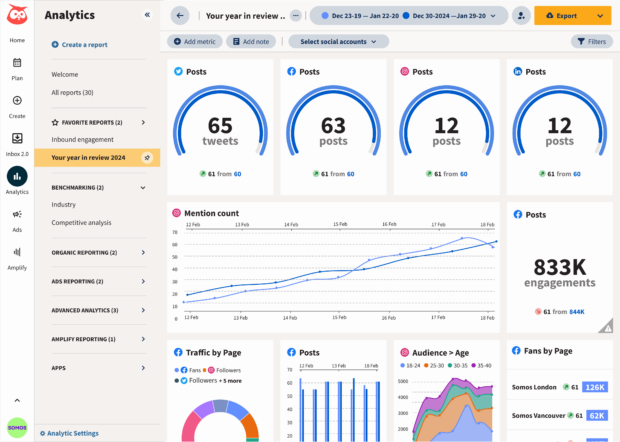
Watch the competition
Watch your competitors to learn what’s working… and what’s not.
Use social listening, social streams, and competitor analysis to discover valuable insights about your customers, business strategies, and industry trends.

Manage your reputation
Even if you haven’t been on social media this whole time, chances are, your fans and customers are… and your haters may be, too.
People might be talking about you without your knowledge, gossiping up a storm on X, or sharing unflattering Instagram Stories slagging your product. If you’re not there to rein in the convo, who knows what might happen?
When Wonderskin saw a bunch of negative comments coming in, they turned it into an opportunity to make a video explaining how to fix some common product problems.
Being active on social media is important for any business interested in protecting its reputation.
Spotting negative sentiment is the first step to nip problems in the bud. And on the flip side, rewarding or celebrating your big fans and cheerleaders may encourage more people to show your brand a little love.
Learn more about social media reputation management here!
Target hyper-specific audiences with ads
Social ads are an inexpensive way to promote your business and distribute content.
They also offer powerful targeting options so you can reach the right audience and make the most of your budget.
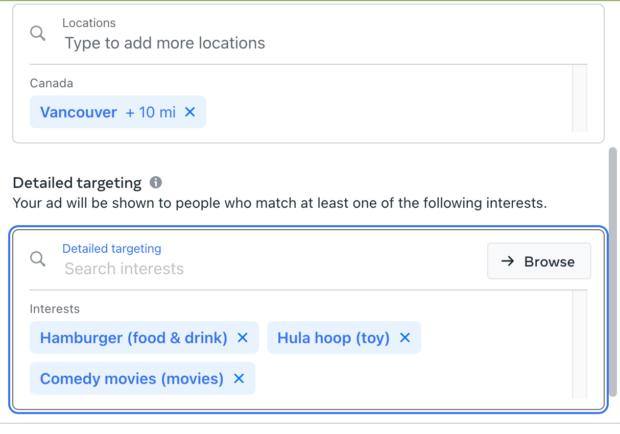 With ad targeting options including demographic information, geography, language, and even online behaviors, you can craft specific messages that best speak to different groups of potential customers and only pay for the exact viewers you want to reach.
With ad targeting options including demographic information, geography, language, and even online behaviors, you can craft specific messages that best speak to different groups of potential customers and only pay for the exact viewers you want to reach.
Prove your ROI
It is always a challenge for marketers to prove a return on investment. But with social media tracking and analytics tools, you can see the full impact of your social media activities, from follows to engagements right through to purchases.
Tools like Google Analytics and Hootsuite Advanced Analytics track website traffic generated from social media, conversions, email sign-ups, and ROI for both organic and paid social media campaigns.
UTM parameters are another great tracking tool that will help you see which social networks are providing the most benefits for your business.

Now that you know the why of using social media for your business, it’s time to get into the how: what steps do you actually need to take to reap all of these rewards?
Set clear social media goals
Without well-defined goals, measuring success and return on investment (ROI) is next to impossible.
Before you start posting up a storm, create a social media marketing goal that follows the SMART criteria (that means specific, measurable, attainable, relevant, and time-bound).
It’s important to avoid getting caught up in vanity metrics like the number of followers and likes — these stats may not reflect the true value of your performance. Instead, focus on meaningful metrics like engagement, click-through rates, and conversion rates.
Need some examples of SMART social media goals? We’ve got you.
Identify your target audience
Social listening tools (like Talkwalker) can offer a wealth of valuable information about your followers. Dig into the numbers to understand demographics, geographical locations, and interactions with your brand.
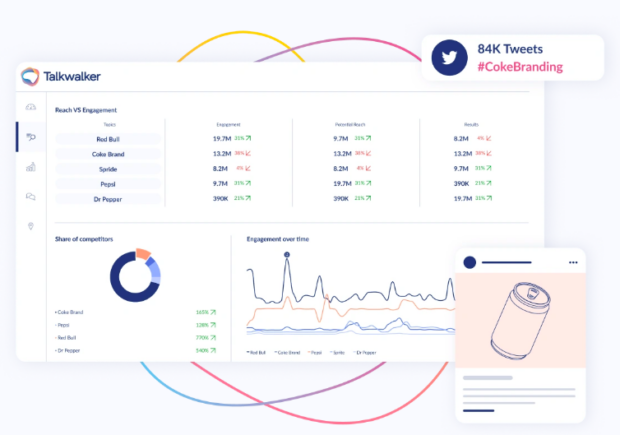
Source: Talkwalker
Talkwalker’s social data library includes more than 150 million sources and measures engagement volume, reach, sentiment, and more. With more than 50 advanced filters, you can segment your social data and understand the full impact of your online conversations.
It’s not just fun to learn about other people, of course. These insights empower you to fine-tune your strategy and tailor your content to better target your audience’s preferences.
Here’s a simple guide and template for creating audience/buyer personas.
Oh, and FYI: Hootsuite is set to acquire leading social listening platform Talkwalker VERY SOON. This means that you’ll be able to dig even deeper into brand mentions and customer intelligence, with Talkwalker’s AI-powered tools right in your Hootsuite dashboard!
Choose the right social media platforms
Social platforms aren’t a one-size-fits-all situation. (This is Instagram, not some sort of magical pair of traveling pants!)
Want to reach cool teens? Ramp up your TikTok presence. Boomer moms, on the other hand, are best reached via Facebook. Put your brand on the platforms that are right for your specific target audience and goals.
Makeup lovers and Rihanna lovers are in abundance on TikTok, making it a great platform for Rihanna’s cosmetics brand to have a presence.
You should also consider which platforms make the most sense for the type of content you’ll be creating.
If short-form video isn’t showcasing your offerings — or making the best use of your resources — then maybe skip the Instagram Reels in favor of focusing on Pinterest.
Conduct a competitive analysis
You know the old expression, “Keep your friends close and your enemies closer”? That goes double for social media.
Wise brands keep an eye on their competitors’ social media activities to learn from their successes and mistakes. More about competitive analysis on social media here.
Of course, starting a social media account and understanding your audience is just the beginning of your social media success story. To really make sure your business’s social media presence is poppin’, follow these best practices.
1. Practice social listening
A little eavesdropping goes a long way regarding social media for business. Set up streams to track discussions about your brand, products, and industry. Monitor mentions — the good and the bad!
Social listening is like a superpower, one that helps you understand customer sentiments and respond effectively to feedback.
2. Collaborate with influencers
Over the past decade-plus, social media platforms have produced their own universe of celebrities. These are people with expertise, influence, and attentive audiences… and savvy businesses know just how to tap into that power.
It doesn’t even have to be a big-name influencer with hundreds of thousands of followers to have an impact.
The tourism board for Nelson Kootenay Lake teamed up with local personalities (micro-influencers, in marketing parlance!) Ruth and Shelby for a guided tour of the region in a recent campaign and connect with their loyal and engaged audience in the process.
If your business is on social media, consider teaming up with an influencer for a campaign or long-term ambassador program. Our influencer marketing guide is a great way to get up to speed on how this brave new world works.
Engage with the social community
Your feed isn’t the only place you can have a presence on social media. Get your butt into the comments section to really make an impact.
When people ask a question or make a notable comment, speak up! It turns social media from a broadcast into a conversation. Bonus points if you’re joining in on the chatter on other folks’s posts.
Social listening is a great way to catch mentions of your brand or posts relevant to your expertise: just set up a stream searching for your handle or a pertinent keyword and then start yappin’.
And if you’ve got a great back-and-forth, a real zinger with a troll, or a clever response to someone else’s post, why not turn that into content to share back on your own feed?
Repost user-generated content
Sometimes, staring at a blank social media dashboard can be daunting, we get it. But if you’ve got a steady stream of user-generated content coming in, you never have to fear writer’s block again.
Encourage customers to share their experiences and content related to your brand, advocating the use of a branded hashtag (#myLevis, #dogStyle, whatever!).
Not only does this repurposed content keep your content calendar nice and full, but sharing user-generated content can act as social proof.
Elvira’s official account shared this fan painting. It’s a win for the superfan and a win for the social media manager looking to add some quality content to the schedule.
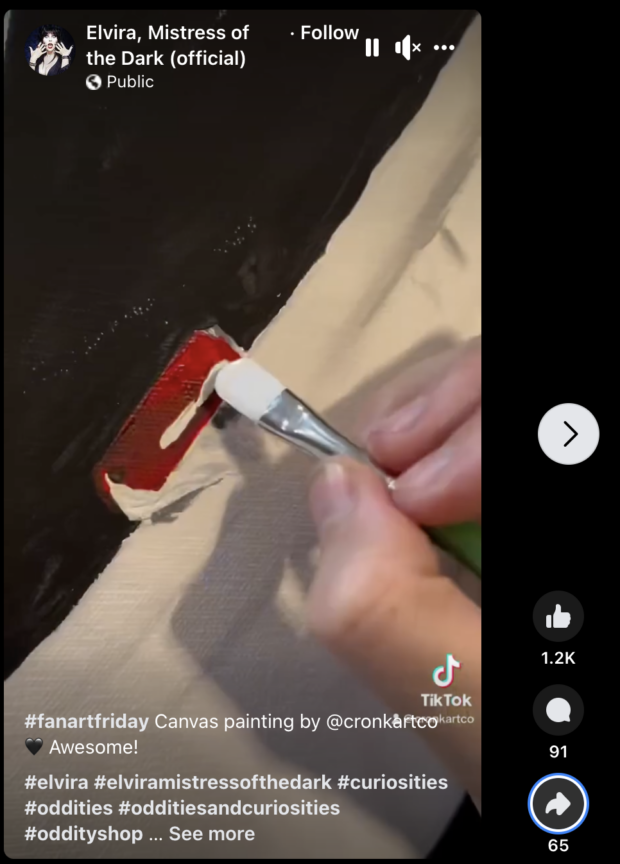
Source: Elvira, Mistress of the Dark (official) on Facebook
Experiment with targeted ads
If you buy an ad in a magazine or on TV, you have some idea of what kind of audience you’re reaching based on the content — fashion lovers are picking up Vogue, foodies are tuning into Masterchef Junior, et cetera.
But social media allows even more specific, distinct targeted advertising opportunities for your business… and you don’t need a huge budget to do it.
Whether you’re boosting an organic post that’s already doing well, or running an advertising campaign across a platform, social advertising can give you instant access to the exact people you want.
Tweak the target based on elements like region, gender, age, interests, and behavior to get in the optimal feeds.
Learn more about advertising on social here!
Learn from your analytics
Knowledge is power!
Use social media analytics to track the performance of your posts and campaigns. Reviewing successes and flops will help you and your team understand what works best, so you can adjust your strategy accordingly and see those key metrics climb up, up, up.
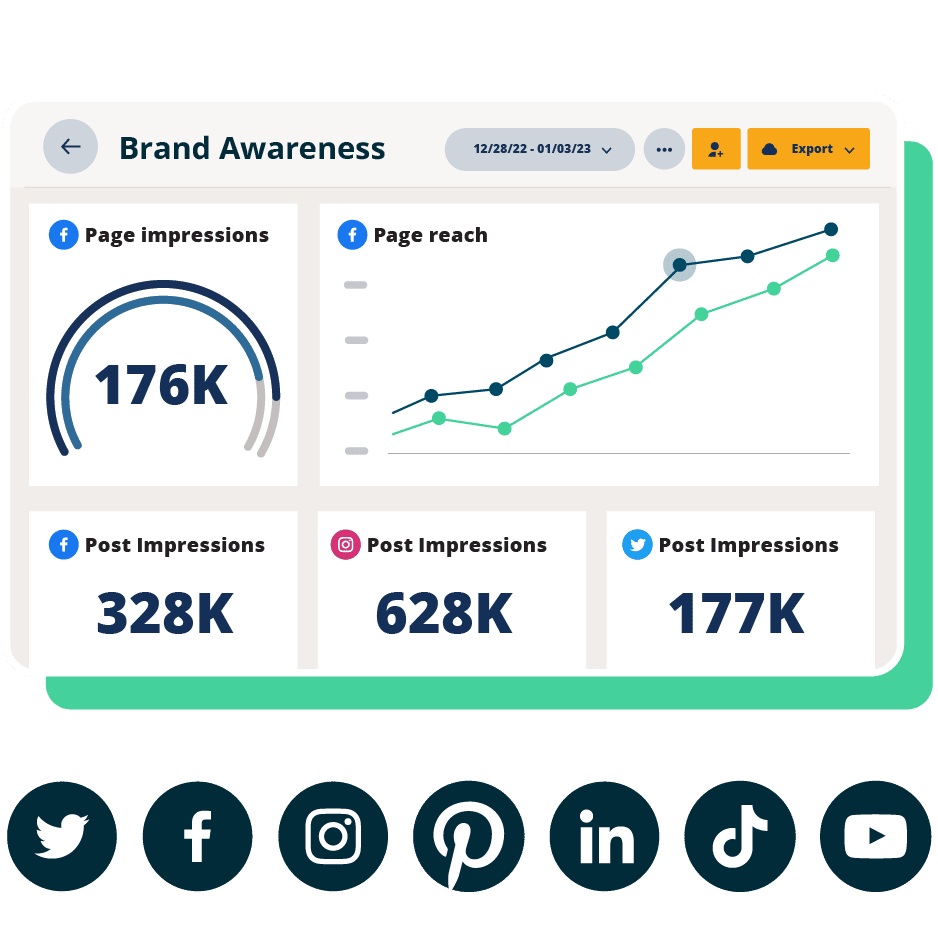
#1 Analytics Tool for Growth
Beautiful reports. Clear data. Actionable insights to help you grow faster.
Post with authenticity and personality
No one comes on social to be fed a boring advertisement.
Get creative, and get real. Be genuine in your interactions and communications. Transparency builds trust, and customers appreciate businesses that are open and honest.
Fashionbrandcompany has built a cult following not just for its creative clothing, but for its avantgarde and funny social media posts.
Watch the trends and stay in the know
Social media is an ever-evolving beast. If you want to stay relevant, you’ve got to keep up-to-date on trends. Follow online tastemakers, keep your eye on the explore page, and generally stay active as a participant.
Even coffee shop Joe and the Juice was getting in on the “I’m Looking for a Man in Finance” trend when it was heating up this spring.
It’s also vital to stay in the loop about the always-changing algorithm of these social platforms — behavior that’s rewarded today may be totally unhelpful tomorrow, so stay tuned to the Hootsuite blog for the latest algorithm intel, and adjust your social strategy accordingly.
Explore more social media best practices here.
Engage with your followers
Social media is a conversation, not a broadcast, so take advantage of this two-way street.
Respond promptly to comments, messages, and mentions. Encourage discussions and interactions on your posts. Engaging with your audience builds trust and loyalty. Caption contest, anyone?
Avoid overly sales-y posts; instead, aim to build a genuine connection. If you brighten someone’s day, teach them something, or give them a moment to relate to, you’re far more likely to make a lasting impression and gain a new follower.
Here are 19 ideas for super engaging posts.
Be consistent
Social media users love someone they can count on. Deliver content reliably, and you’ll be rewarded. Regularly sharing content helps to build brand awareness and keeps your business fresh in the minds of your followers. Maintain a consistent posting schedule to keep your audience engaged.
Crayola posts a craft idea to Facebook each Friday, so all the craft-heads out there know they can count on something fun for their weekend plans.
Hone your hashtag and social SEO strategies
Though many platforms are upping their search functionality, hashtags still help increase visibility and attract a broader audience.
If you sell books, add #booktok to your caption to reach a community of literary obsessives; if you’re a company based in Edmonton, Alberta, tag your posts with #yeg to help Edmontonians discover your content. (Here’s our guide to using hashtags for every social network to help you get started.)
The Arizona Coyotes use the same #YotesForever tag in their X posts that their fanbase does.
To the most loyal & amazing fans… we love you 🤍 #YotesForever pic.twitter.com/tjYgMU0YDN
— Arizona Coyotes (@ArizonaCoyotes) April 18, 2024
But beyond #using #the #pound #sign, it’s also important to include keywords in your captions, to help the search-bots categorize your content.
Yes, you want to be interesting and engaging in your posts, but make sure you’re being clear, too.
“So I did a thing” may be fine for captioning your personal Instagram bungee-jump picture, but that renders it utterly unsearchable. For your brand, be descriptive and helpful. More on mastering the art of social SEO here.
Create content that people actually enjoy
You could spam people with 100 meaningless posts a day… or you could focus on creating high-quality and valuable content that actually provides solutions, entertains, educates, or inspires. We know which one we’d rather see in our feeds.
What’s more fun? A straight-up product pic of a crystal bracelet, or a cheeky “moods of the week” carousel that imbues the bracelets with hyper-specific character traits? Jewellery company Freshly Unbothered answered correctly.
Run contests and giveaways
Fact: People like free stuff.
Organize fun and creative contests or giveaways to boost engagement and attract new followers (we’ve got 12 inspiring examples right here). It’s a great way to both reward your existing audience and gain more visibility.
Whether you’re running a small business or representing a bustling enterprise, social media marketing should be part of your game plan.
Arming yourself with the right social media marketing tools is going to make your marketing life so much easier. Here are a few of our faves for business (but we’ve got even more recommendations if you’re ready to take things further).
1. Hootsuite
Not to brag, but Hootsuite is an easy-to-use, comprehensive social media tool designed to cater to both individual entrepreneurs and large teams.
If you want to streamline your social media efforts effectively, you’ve come to the right place. (And if you haven’t tried Hootsuite yet, we’ve got a free trial with your name on it.)
Hootsuite’s social-focused features provide a centralized platform for the entire social media marketing process: creating, scheduling, optimizing, and tracking social media posts.
Here’s how it works in 60 seconds, if you’re short on time:
With Hootsuite Composer, you can effortlessly plan and share content across various channels, including Instagram, X, LinkedIn, and YouTube. (For added convenience, Composer seamlessly integrates with useful tools like Canva and our in-house social AI tool, OwlyWriter.)
Using Hootsuite, you can easily repurpose your best-performing posts, identify and correct typos, upload branded graphics, and receive valuable recommendations for optimal hashtags and posting times.
Another super helpful feature for business is the Hootsuite Inbox. Inbox pulls all social media messages and interactions into one unified interface, regardless of platform.
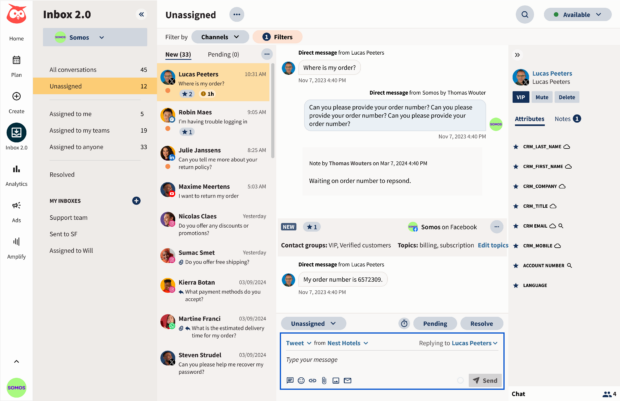
Hootsuite Inbox simplifies conversations and customer service, enabling you to reply swiftly and trace a person’s interaction history with your brand, ensuring no customer is ever left hanging.
2. Canva
If you’re flying solo or have a small social team without a graphic designer, Canva is the go-to for crafting original and branded graphics. There’s a reason it’s a favorite tool among social media marketers.
Regardless of your design background, anyone can use Canva’s templates and fool-proof drag-and-drop design functions to create stunning visual content.
If you already have a Hootsuite account, you can easily connect it to Canva for direct access to upload and use your creative assets right in Composer. Ooh la la!
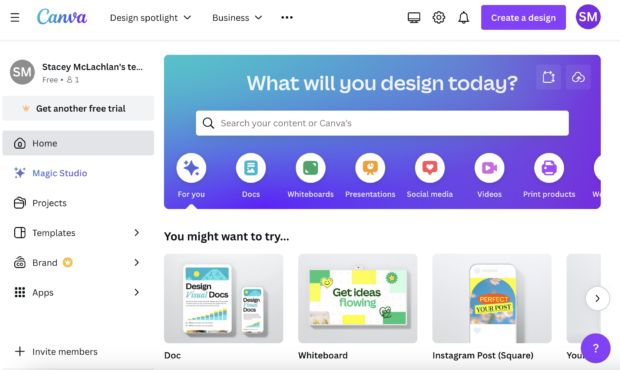
3. Grammarly
At best, a typo can make your posts look sloppy and unprofessional. At worst, they can cause confusion. So getting a little help with the proofreading process is definitely a good idea, which is where Grammarly comes in.
The AI tool helps grammar and spell-check text, but it can also review for tone and clarity. The latest updates to Grammarly even include text-generation and brainstorming features.
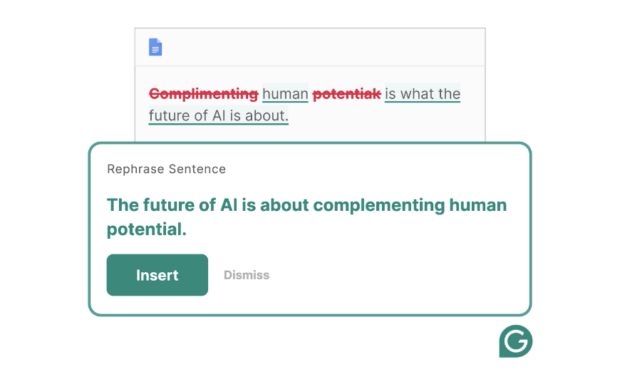
4. Google Analytics
First things first: Google Analytics is absolutely free. Second thing’s second: Google Analytics is going to be incredibly helpful for tracking and measuring your business’ traffic goals.
Want to prove the ROI of your web and social media presence? Analytics is here to help.
Google Analytics collects info on converted leads, where traffic comes from, demographic data, individual page traffic, and much, much more. With more than 56% of all websites using Google Analytics, it’s one of the most popular tools out there for digital marketers.
Here’s our step-by-step guide for setting up Google Analytics, and here’s a breakdown of how to track social media in Google Analytics.
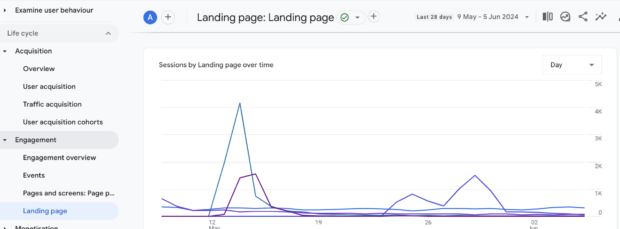 Save time managing your social media presence with Hootsuite. Publish and schedule posts, find relevant conversions, engage your audience, measure results, and more — all from one easy-to-use dashboard. Try it free today.
Save time managing your social media presence with Hootsuite. Publish and schedule posts, find relevant conversions, engage your audience, measure results, and more — all from one easy-to-use dashboard. Try it free today.
Do it better with Hootsuite, the all-in-one social media tool. Stay on top of things, grow, and beat the competition.
This post was originally published on this site be sure to check out more of their content







